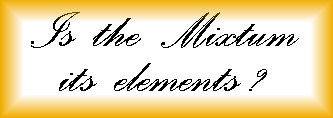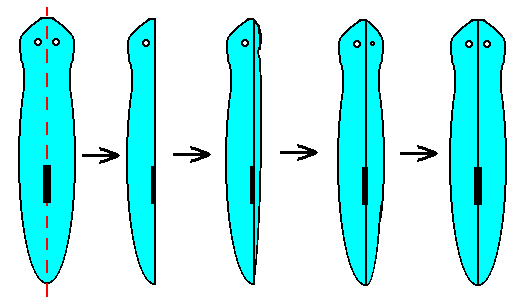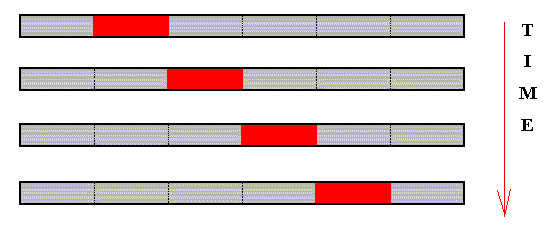

nr. 1631.About the mixtum and its elements St Thomas (or perhaps, pseudo Thomas) also writes in De Natura Materiae et Dimensionibus Interminatis, namely in Chapter 9, just after its beginning.
"Here the Philosopher [ by "the Philosopher" is always meant : Aristotle ] clears up a point which remained a difficulty above, namely, how a substance is composed of parts, when he showed above that a substance could be composed neither of its accidental attributes nor of actually existing substances. Therefore he shows here that the parts of which substances are composed are not actually existing substances but potential ones. He says that, since it was stated above that there are some things which are thought by all to be substances, namely sensible substances and their parts, it is evident that most substances of this kind are potential and not actual, as is clear of the parts of animals and all other parts.
nr. 1632.
He says that the parts of these substances are many, because since each whole is composed of many parts, there must be more component parts than composite wholes. And it is evident that parts exist potentially, because none of them are separate, but all parts as parts are rather united in the whole.
nr. 1633.
For everything which is actual must be distinct from other things, because one thing is distinguished from another by its own actuality and form, as was stated above. But when those things which are assumed to be parts have been separated from each other when the whole is dissolved, they are then actual beings, not as parts but as matter existing under the privation of the form of the whole. This is evident, for example, of earth, fire and air, which, when they are parts of a compound, are not actually existing things but exist potentially in the compound. But when they are separated, they are then actually existing things and not parts. For none of the elements "before they are arranged," i.e., before they reach their proper state of mixture by way of alteration, and before one compound comes from them, together form a unity, except in the sense that a heap of stones is one in a qualified sense and not in an unqualified one. Or better "none of them," i.e., they do not constitute a unity before some one thing is produced from them by arrangement.
nr. 1634.
For even though all parts exist potentially, someone might very readily suppose that the parts of living things and those of the soul [ I continue here with a corrected translation, after having signalled an error in the ROWAN translation of this sentence : are close [ to their act ], implying that they are considered as in act and [ also ] as in potency ], i.e. they are in potentiality close to actuality. And the reason is that living bodies are organic bodies having parts which are formally distinct. Hence they most of all are close to being actual. And this is because they have a principle of motion in some determinate part, since one part moves another. This is clear, for instance, in the case of their joints, in which the principle of motion of one of the two connected parts seems to be found, since one can be moved and another at rest, as is stated in The Motion of Animals.
nr. 1635.
And since not only the parts of the body are in potentiality close to actuality, but also the parts of the soul, therefore some animals live after they have been divided, as segmented animals. And this is possible because in the whole animal there is one soul actually and there are many souls potentially. But when division is made the several souls become actual. This happens because of the imperfection of such animals which require very little diversity in their parts, for they have a soul with imperfect ability to function and incapable of acting in different ways, for which a number of different organs are necessary.
nr. 1636.
Yet even though these parts of the soul and the parts of living things are close to actuality, nevertheless they are all potential when the whole is one and continuous by nature. But this would not be the case if one thing came into being by force, as, for example, when the parts of one living thing are tied to those of another, or by grafting, as happens in the case of plants. For before the scion which is to be inserted is united with the plant, it is actual, but afterwards it is potential. "For such a thing," namely, to be one by force or grafting, "is a mutilation," i.e., something injurious to nature and opposed to nature."
What is the ontological status of the elements in a mixtum, in this case a genuine mixtum (not a mixture), for example a molecule of a chemical compound, a crystal or an organism?
In Scholastic texts (as for examlple St Thomas') one poses that if the elements are actually present in a mixtum, then this is not a genuine mixtum, but an aggregate. So in a genuine mixtum the elements would only be virtually present.
Again we have the problem of being-a-Totality.
In In VII Met. lectio 14, nr. 1598, St Thomas distinguishes three kinds of physical 'joining together' (merging), which he makes clear by the following examples (on which I give some further comments):
"It is however certain that in a part, that is separated from the whole, a substantial form is present : that's why the part is, [ as residing ] in its whole, in a potency that has maximally approached its act, because it is impossible to assume a dual substantial being in the same thing, as is said above, [ and because one ] also [ should ] not [ assume such a dual substantial being ] as a consequence of one or another preceding change, [ and because one ] also [ should ] not [ assume ] that a new form is induced, unless through a change."The new form of the part is not induced until by a change, i.e. when the mixtum has been subjected to a change, in such a way that it has been disintegrated into its parts, which then have become actual.
Flatworms do not consist of a succession of more or less identical metamers (sequential segments) placed behind each other. But they do consist of two antimers (counterparts) : These are parts lying next to each other, and are – in the case of Flatworms – their right and left body halves. When such a flatworm is divided through its median plane (i.e. when the body halves – antimers – are separated from each other), then each antimer develops into a whole animal again, now again consisting of two antimers. See next Figure.

Figure 1. The regeneration of a complete flatworm ( of the genus Planaria ), cut as indicated on the left.
( Redrawn after SHELDRAKE, R., 1988, The Presence of the Past (Morphic Resonance and the Habits of Nature), Figure 5.3, p. 77. )
Higher animals -- "animalia perfecta" in the treatise -- lack such a idem specie divisibility. They are, to be sure, divisible, but the several beings resulting from division are not conspecific with the initial form anymore.
In the mentioned treatise a metaphysical explanation is attemted in Chapter 9, the investigation of which I would like to postpone for the time being.
Important and interesting however is that such a divisibility, which does not preserve specific identity, does not relate to 'height' (in the sense of being a higher organism) of the being in question, as is asserted in the treatise, because this phenomenon also occurs in the case of molecules, existing on their own, i.e. not in one or another repetitional frame, but freely in gasses or in non-ionizing solvents. It appears inevitable to me that molecules (which as such were not known in the Middle Ages, at most in the form of the theoretical minima) must be considered as Substances.
The impossibility of idem specie division seems to me to be related to the degree of unity of the thing in question. This unity is strong in the case of a molecule, weaker in the case of a crystal, and strong again in the case of higher organisms. The unity of a human being is actual, and he does not possess a potential multitude idem specie within himself [NOTE 2], while this is the case with crystals, but absent again in the case of molecules. If we divide the latter, then we get specifically different products.
Strong unity, as can be observed in the case of organisms, returns in the submicroscopical domain.
Coherent with the Totality character of a Substance is the way of being of the elements in the mixtum perfectum ( In the mixtum imperfectum, the mixture, the aggregate, the way of being of the elements is always an actual one).
Let us discuss the meaning of the following expression :
The conservation of (some) properties of the elements in the mixtum
Expressed in this way it is a low-level consideration. The corresponding high-level consideration is as follows :
In the mixtum perfectum, once formed, the conserved properties do not originate from a simultaneous presence of the qualities of the elements. The 'average' quality (i.e. how it behaves, and looks like) of the mixtum originates from the (one) Form of the mixtum. Nevertheless it displays a similarity with some properties of the elements, in virtue of the 'genetic' kinship of the mixtum and its elements (After all, the mixtum originated physically from the elements). The elements themselves are present only in a virtual way (i.e. in a near potency to those elements), so also some of their properties. These properties have now become properties of the mixtum, they are generic propria (i.e. they are properties, typical for a particular genus).
Genuinely new properties of such a real mixtum can be considered as a Totality-resultant.
Precisely such a type of Totality must be demanded, if one assumes that every Substance possesses only one substantial form.
At first sight this is a completely different way of seeing things than the one by which we see the mixtum as a Whole that is generated by the interaction of the parts, i.e. a strong interaction such that the parts display an intrinsically organized connection leading to the Totality in question. But we can, as already suggested, interpret this formulation as a low-level consideration, i.e. a consideration at the level of the elements, of which some properties are conserved.
The (above) high-level description departs from (i.e. starts with) the mixtum : the elements are exclusively considered in their relation to the mixtum. It is only the mixtum that IS. The way of being (the way of being present) of the elements is virtual. However this virtual way of being of the elements (the parts of the mixtum) is hard to harmonize with their activity. In the case of crystals this activity is minor, but in the case of organisms there is a strong cooperative interaction of parts, and then the continuum view becomes problematic.
So it seems better to let the virtuality of the elements depend on the type of consideration : The elements are present in the mixtum in an actual state (in which interaction is possible) within a low-level consideration, while they are only virtually present in the mixtum, within a high-level consideration. The mentioned activity of the elements would then have to be interpreted as the activity of the mixtum. With all this we anticipate a treatment of such levels in a special Essay later on.
The high-level consideration can, as is said earlier, ascribe a character of causality to the Form of the mixtum (its substantial form) because the elements, in their interactions, are directed to the Whole (the particular individual mixtum) in virtue of which this Whole is, in a sense, already, 'presupposed' by its parts. Such a holistic behavior is indeed observable with respect to a number of mixta, for example :
When the lens of a newt's eye is removed surgically, then a new lens is being regenerated from the margin of the iris. The remarkable fact is that the lens is formed in the normal embryological development in a completely different way, namely from skin tissue. Because of the purely artificial character of the surgical maiming, this capacity for regeneration cannot have been developed evolutionarily -- through natural selection, because such an event never happens in Nature (See SHELDRAKE, R., 1981, A new science of life, p. 24/25, in Paladin Books, 1987 ). In this case it is clear that the parts are directed towards the Whole, i.e. they presuppose that Whole (But see NOTE 3).
Also in the case of crystals we can observe an accelerated healing of injury, during the growth of a crystal, that is deliberately damaged.
The Whole has -- as we could express ourselves -- a substantial form which acts in a guiding, controlling way on the parts.
In the case of a genuine Aggregate the properties of that aggregate are the properties of the elements (additive properties, like the weight of that aggegate), unless we have to do with emergent aggregation-resultants (like the blue of the sky). These are not just the result of the 'many-ness' of the element particles, but of a many-ness exceeding a certain more or less critical value, giving rise to new properties. These properties however derive, just like that, from the presence of that multitude of element particles, i.e. they derive wholly from that multitude of element particles.
Further examples of emergent aggregation-resultants are : temperature, and pressure. They only appear in the case of larger quantities of matter, hence from larger numbers of aggregate elements. They are constitutive properties of the aggregate. So we have :

Figure 1. Visualization of a moving part that is virtual, and consequently a quality. Movement of virtual parts generally is a continuous redistribution of qualities within the Totality. Here one such quality (red) is shown (against a background quality (grey)), as it shifts from left to right. This shift of the quality is not a movement but an ongoing replacement.
Those virtual parts exist however in a near potency to their act, as has been said, and we should (thematically) investigate what this should mean precisely. For how can something act, i.e. (constantly) execute its function (like the beating of the heart), when it exists only potential (even if it is a near potence)?
A possible consideration is : that an organism is not a genuine continuum after all, but a tight, organized contiguum, in contrast with, say, a granite pebble, which is a genuine aggregate (of crystals), and so not an organized contiguum.
What could be the metaphysical implications of such an assumption?